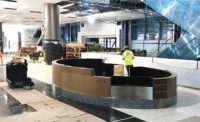

A lengthy delay mandated by the governor, a rebid and a fierce debate over the design of the new San Francisco-Oakland Bay Bridge were just the beginning. Over the course of the 11-year construction period came allegations, faulty rods, foundation questions and even an FBI investigation on the $6.4-billion crossing, which was completed last year.
"It was a once-in-a-lifetime opportunity," says Pat Lowry, president of Alta Vista, which received its fair share of public scrutiny as the provider of inspections and materials testing. "At the end of the day, when you drive across that bridge that you worked on, nobody will ever be able to take that away from you."
Completed six years later than the original 2007 target date, the two-mile-long bridge with a 1,263-ft-long, self-anchored suspension span uses innovative designs to withstand a major earthquake and stay open for emergency vehicles. Yet, media coverage of the construction issues "left the reader with the feeling the bridge was not safe," says Marwan Nader, project manager with T.Y. Lin International, the lead designer of the suspension span. "It's probably the safest bridge in the nation."
As for the bolts, "they amounted to $25 million on a $6.4-billion project," says Nader. "It's a punch-list item. The state went in and studied it for months with national experts who said the bridge was safe."
A "lessons learned" report prepared for the California Dept. of Transportation noted that media briefings regarding the rods were held only after regularly scheduled commission meetings. "The media had come to expect regular briefings in the field from the project team speaking with one unified voice," stated the report. "Having the media wait to receive updates ... affected transparency and trust ... and resulted in reporters turning to unofficial sources."
Lowry notes that in today's social media environment, reporters can't wait long. Also, "we're being asked to take a complex subject and simplify it into a nice little story. That's almost always going to distort reality. A comprehensive communications strategy for a megaproject is as important as a defined budget and schedule. That's something new for our industry—we're not comfortable with embracing transparency, but we need to go there."
Communication between project partners proved to be key, too, says Brian Petersen, project director with American Bridge-Fluor, the JV contractor. "We all started embracing one goal—to get this bridge open. We began focusing on the work rather than on protecting our own interests. You do have to protect your interests, but this was 'all in' for us."
But the team solving problems, he adds, "isn't going to sell papers. There's no spin to the story."
Last fall, the California Highway Patrol cleared Caltrans of claims that it retaliated against whistleblowers regarding welds. "There was no corruption. There was no fraud; no collusion or coercion or kickbacks," says Bonnie Lowenthal, former 70th State Assembly district representative. "We can't allow short-sighted journalism to make engineers afraid to build another marvel. It wasn't easy to get through this process and it won't be easy for the next marvel that's developed."
Nader emphasizes that public involvement influenced the design from the beginning. "If not, it would have been an engineered solution only," he says. "The team was able to deliver something that the public wanted on top of the solution."




Post a comment to this article
Report Abusive Comment